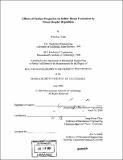Effects of surface properties on solder bump formation by direct droplet deposition
Author(s)
Hsiao, Wen Kai, 1972-
DownloadFull printable version (24.61Mb)
Other Contributors
Massachusetts Institute of Technology. Dept. of Mechanical Engineering.
Advisor
Jung Hoon Chun.
Terms of use
Metadata
Show full item recordAbstract
Recent advances in microdroplet generation and deposition processes have made it possible to directly form solder bumps on integrated circuits using micron-sized molten metal droplets. The direct droplet deposition bumping process can potentially produce uniform-sized bumps more economically than the existing processes such as plating and stencil printing. However, the development of this new bumping method is still in its infancy, particularly because of a lack of understanding about the post-impact deposition behavior of molten droplets on solid targets. A deposited molten on the deposition efficiency, as well as on the final bump size and shape. The present study investigates the effects of wetting and surface roughness on droplet bouncing during solder bump formation. The potential for droplet bouncing is modeled based on the energy difference between the maximum spreading and equilibrium sessile stages of a deposited droplet. Validated by experimental results, the model shows that strong droplet-surface wetting can significantly reduce the tendency for a deposited droplet to bounce. The effect of surface droplet can sometimes recoil violently after the initial spreading and rebound off the target surface. Such behavior, known as bouncing, has a strong influence roughness on the bouncing potential is represented by the roughness-induced incomplete wetting during droplet deposition, a phenomenon quantified by a change in the effective contact area under the deposited droplet. An idealized surface model is used to represent the real surface and to describe the relationship between various roughness parameters to changes in the effective contact area. The theoretical analysis, validated by empirical data, shows that surface effective (cont.) contact area. The theoretical analysis, validated by empirical data, shows that surface roughness promotes bouncing during solder bump formation. The results from this study suggest that droplet bouncing during solder bump formation may be effectively controlled by improving the surface wetting and minimizing the substrate surface roughness. The knowledge gained is also relevant to other droplet-based manufacturing processes such as spray forming, coating, and rapid prototyping.
Description
Thesis (Ph. D.)--Massachusetts Institute of Technology, Dept. of Mechanical Engineering, 2004. Includes bibliographical references (leaves 158-162).
Date issued
2004Department
Massachusetts Institute of Technology. Department of Mechanical EngineeringPublisher
Massachusetts Institute of Technology
Keywords
Mechanical Engineering.